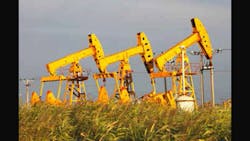Report Urges California To Step Up Fracking Regulations
Without careful monitoring and controls, the process of extracting gas through hydraulic fracturing, or “fracking,” could result in irreversible surface and groundwater contamination, according to a new report focusing on California’s fracking industry. The researchers call for stronger regulations and controls in order to better protect the environment and public health.
Fracking is a technique that injects highly pressurized chemical fluids into underground rock to create cracks that release tightly bound oil or gas. It’s become a financial boon to fossil fuel companies nationwide, but it comes with inherent dangers, said researchers from UC Berkeley School of Law’s Center for Law, Energy and the Environment (CLEE) and its new initiative, the Wheeler Institute for Water Law and Policy.
Researchers say the risks of fracking include toxic chemicals and known carcinogens that can seep into ground and surface waters, posing a threat to human health, aquatic life and ecosystems. If the fracking wells and wastewater are mishandled, the results may be harmful, costly and impossible to reverse, according to the report, “Regulation of Hydraulic Fracturing in California: A Wastewater and Water Quality Perspective," an independent analysis of fracking practices in California.
Greater Industry Oversight Needed
While fracking itself is not new – oil and gas producers have employed it in California for many decades – there are now projections of dramatically increased activity in California driven by advanced technologies and a demand for oil. Researchers consider the state’s uptick in fracking activity “potentially alarming.”
“The rapid spread of fracking has outstripped the ability of state agencies to effectively monitor and regulate it. Our recommendations include a greater investment in industry oversight, stronger regulations, and heightened inter-agency cooperation,” said Jayni Foley Hein, a report co-author and executive director of Berkeley Law's environmental research center. “Regulators need to protect the public interest by demanding greater transparency and increased accountability across all fracking operations.”
In an unusual twist that is contrary to its role as a leader in environmental protection law, California lags behind other states on hydraulic fracturing regulation. Wyoming, Ohio and other states set stronger standards for transparency, safety and environmental stewardship. But even in those cases, gaps in agency oversight may have contributed to water contamination and greater seismic activity.
Raising the Bar
California needs to raise the bar even higher, said co-author Michael Kiparsky, an environmental scientist and associate director of the Wheeler Institute. He asserts that scientific uncertainty, due to a lack of peer-reviewed studies, drives the need for more research on fracking’s potential risks.
The report makes several recommendations for California’s fracking industry, including:
- Providing advance notice and disclosure of fracking events;
- Developing a formal process for concerned citizens to respond to proposed fracking events;
- Implementing more extensive recordkeeping and reporting of disposal of wastewater;
- Strengthening the state’s definition of underground sources of drinking water to match or exceed that of the EPA;
- Developing a well closure and monitoring program in the state;
- Prohibiting underground injection near risky faults based on seismic analysis;
- Considering tax exemptions to encourage recycling of fracking wastewater;
- Implementing regulations to explicitly prohibit direct discharge of wastewater from oil and gas operations to publicly owned treatment works until the EPA issues pretreatment guidelines;
- Launching a state-funded, comprehensive scientific review of the risks to California water supplies from fracking wastewater.
“Part of the challenge of fracking is that the technology is constantly evolving,” said Kiparsky. “It’s essential that regulators not only understand the impacts of new technologies, but also study the lessons learned elsewhere to prevent an increased risk of earthquakes, water pollution and toxic air emissions.”
About the Author

Laura Walter
Laura Walter was formerly senior editor of EHS Today. She is a subject matter expert in EHS compliance and government issues and has covered a variety of topics relating to occupational safety and health. Her writing has earned awards from the American Society of Business Publication Editors (ASBPE), the Trade Association Business Publications International (TABPI) and APEX Awards for Publication Excellence. Her debut novel, Body of Stars (Dutton) was published in 2021.

